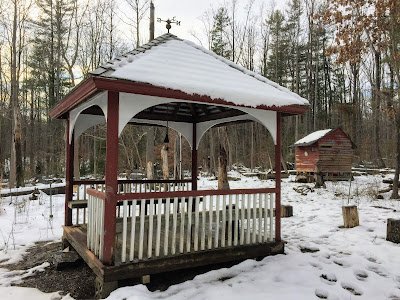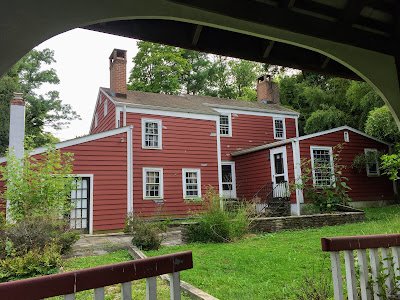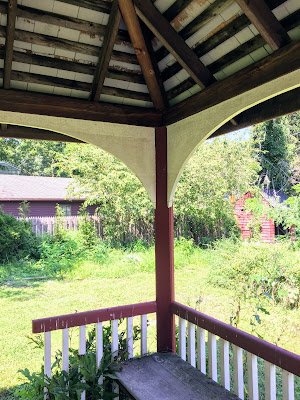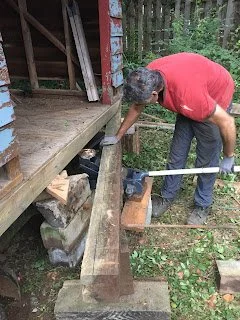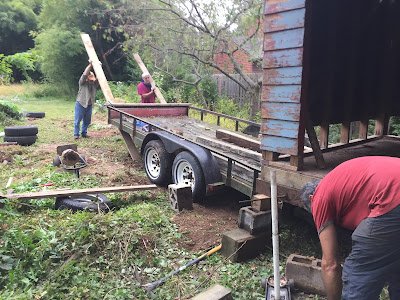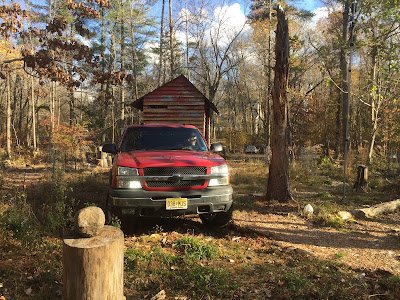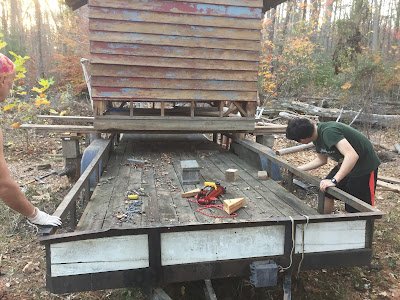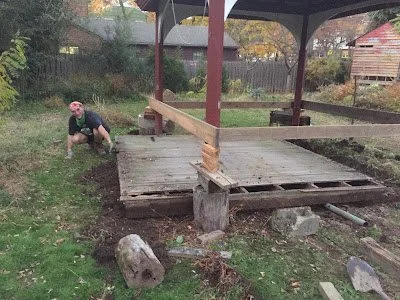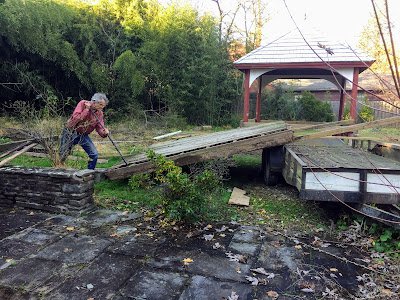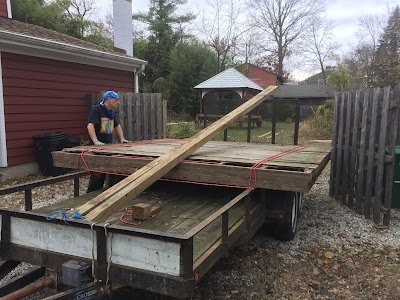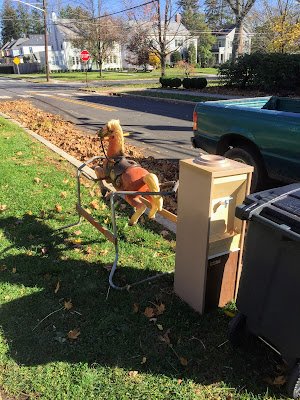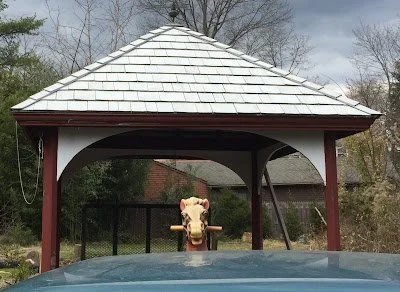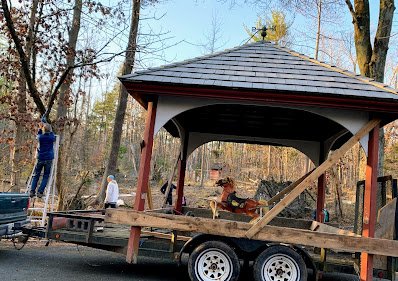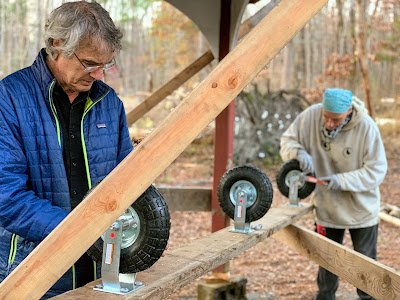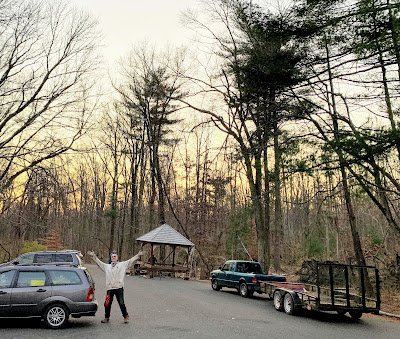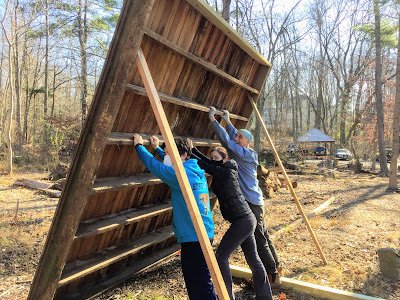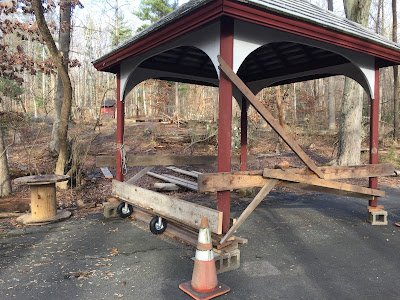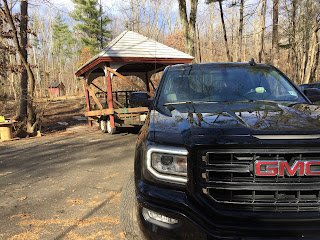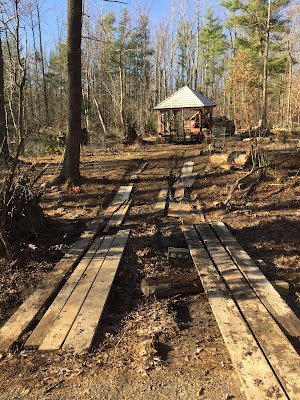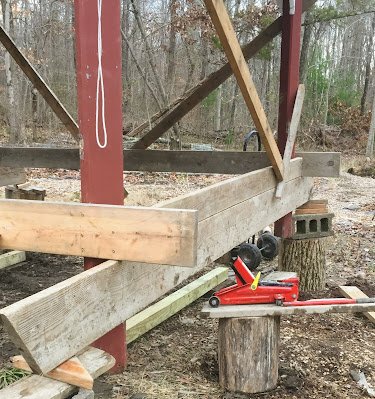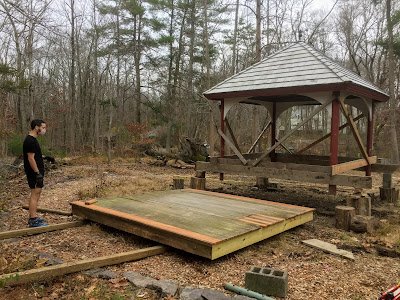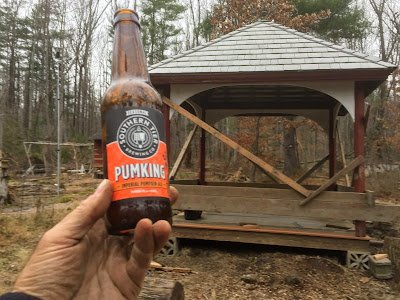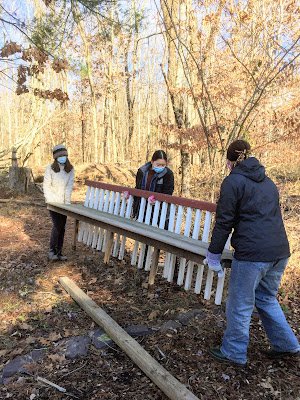Gazebo Docks With Mother Ship
Herein lies the story of the moving of the gazebo and shed, which played out from August through November in that year of years, 2020.
At some point this gazebo and shed will come to look like they've been in the Princeton Botanical Art Garden forever. But so involved and challenging proved the moving of them from their original home at 145 Ewing Street that, when we eased the gazebo's four posts back down onto its base, it felt like we'd just pulled off a mission to the moon.
Below is the story of all those who helped, of uncanny coincidences, and an unlikely challenge answered with resourcefulness, imagination, strength, and above all persistence. Click on "read more" to open the whole post.
The gazebo first entered our awareness as an attractive framing device in an online photo of a house on Ewing Street that went up for sale in 2019. Parts of the house turned out to date back to 1755, and when some of us neighbors learned that the new owner was going to have to tear it down in order to realize plans for a duplex, we began raising a fuss. The fuss expanded considerably after a post to the "I grew up in Princeton" facebook page, prompting the town to modify its regulations so that the new owner could save the house as part of her plans.
It seemed like a happy ending, but proved to be just the beginning of an adventure.
In the lovely garden behind the house stood the gazebo that would need to be demolished to create the new owner's duplex.
With mahogany floor and benches, and cedar shake roof, it seemed a shame to tear it down, and so we asked the new owner if we could move it to Herrontown Woods. She said yes, and we thought "Great!", followed quickly by "Now what?"
The gazebo was too tall to fit under the powerlines criss-crossing the streets. How do we make it short enough and light enough to transport it a couple miles across town? There were thoughts of jacking up its roof and moving the base and posts separately, or cutting it into four pieces to make it light enough to handle, but each idea involved pulling or cutting through many nails, and became less practical the more we thought about it.
We decided to gain some experience first by attempting to move the shed, which too was in need of rescue. Despite the peeling paint, it was still a sound structure, and would come in handy at our botanical garden for storing tools.
While gathering courage and a plan, we began by giving it a good power washing, thanks to new volunteer Robert Chong. It helped that one FOHW board member owns a trailer, and another owns a small pickup truck. We searched youtube for ideas on how to lift the shed high enough to get it onto the trailer. Finally, we posted on Freecycle that we were looking for a jack strong enough to lift a shed.
Enter an angel to assist us, Joe Guarnaccia, who owns a historic house on the west side of town and offered not only his hydraulic jack but also his help in what turned out to be two extended sessions during which we slowly raised the shed up, bit by bit, one side then the other.
A jack is a kind of miracle, allowing us to perform superhuman tasks, lifting the unliftable with easy incremental strokes of a handle. Oswald Veblen's method of bringing his ideas to fruition has similarly been compared to the dripping of water on a stone--achieving an incremental erosion of resistance. One of the few things I remember from 5th grade was a skit I performed about simple machines. Smoking a Swiss pipe filled with flour for smoke, I played a savant explaining the improbable power of levers, wheels and inclined planes.
It was through this incrementalism that we raised the shed until it was suspended high enough above the ground to slip the trailer underneath. Keeping the shed levitated were cobbled together columns of logs, blocks and boards--a little teetery at times, but adequate for our purposes.
Joe showed us how to use his small but remarkably strong jack, and how to use leverage to greatly increase our limited human power to move stubborn objects. This how-to would prove invaluable throughout the process. A small hydraulic jack, in turns out, only costs about $35, but ignorance of that got us Joe's assistance and mentoring.
After the shed was safely perched on the trailer, several weeks passed while we hemmed and hawed about how to transport it to Herrontown Woods. It seemed too heavy for my '94 Ford Ranger. Four-wheel drive seemed a good idea for pulling it up into the botanical garden. Finally, a friend of Andrew's, Rich Ruben, offered to help with a big truck he had just acquired. Just getting the shed safely past the gazebo and out onto the street required some delicate maneuvering. Running through the whole endeavor was a vexing mix of massiveness, delicacy and improvisation. Rich's resourceful nature merged with our own to make it possible.
Though we had scouted the route ahead of time, measuring the height of the wires with a bamboo pole, there was relief each time the shed dipped safely beneath a wire. This is our Abbey Road shot, except its Franklin Ave and instead of the Beatles it’s an old shed.
The shed caravan arrived to much acclaim at the Herrontown Woods, parking lot, followed by elaborate prep to begin the 100 foot assent into the botanical garden.
Boards were laid, shrubs were pruned back, strategy was set. There was premature celebration followed inevitably by some glitches that had to be worked out.
We now pause this post for the first of two truck commercials.
After Rich pulled off an elaborate K turn amongst the trees, we jacked the shed up above the trailer and slipped the trailer out.
And there the shed remained for a day or two, up on stilts, until we could lower it back down, bit by bit, one side then the other.
Factoring procrastination and life's competing demands, moving the shed had required nearly two months. During that time, I frequently felt pulled as if by one of those tractor beams in Star Trek, as my subconscious grappled with the challenge of how to move the gazebo. Every strategy we came up with had problems. How to make it low enough, light enough, while minimizing the need to dismantle and dismember.
Finally, around 4am on the morning of October 30, I had a dream about two horses, one partly buried and in need of excavation. The dream's meaning was obscure, but sometimes it's the thoughts you have after awaking from a dream that matter more than what actually happened in the dream. This time, I awoke with the solution for moving the gazebo.
We had been storing large boards next to the Veblen garage, scavenged a year or two prior, thinking they would prove useful at some point. Now those boards would finally be put to use. Screwed to the four posts of the gazebo, they would serve as a means of lifting the gazebo up off of its base. Only a couple nails needed to be removed from the bottom of each post, and the benches proved easy to pull out.
With the gazebo jacked up on stilts, we'd then pull the base out, using metal tubes from old jack posts to serve as rollers.
Other volunteers not being available one day, I was able to load the heavy base onto the trailer myself, using nothing more than rollers and a pry bar.
The base headed over to the botanical garden with the metal tubes and the two runners, upon which we were able to roll it up the slope and into position in the botanical garden, using pry bars and a couple hand trucks. Peter Thompson and Andrew Thornton reprised their roles as lever-meisters.
The mahogany benches and railings headed over in the truck.
Next step was to slip Ahmed's trailer under the gazebo, just as we had with the shed. An important feature here is that the gazebo's four posts hang down over the edge of the trailer, which would hopefully reduce the height of the gazebo enough to slip under the power lines.
It helped, too, to remove the flying pig weather vane.
After carefully measuring the height of the gazebo on the trailer, and checking the heights of power lines and traffic lights along the route, moving day arrived, with Andrew as escort and Kurt Tazelaar playing the role of scout to double check heights each time we approached a power line.
It should be noted that, just ten days before the great moving day, I had happened to take a different route across town and came upon a spring rocking horse, set out on the curb on Aiken Avenue. Our project at Herrontown Woods being very much about delight, I picked it up. The horse proved a big hit with kids on Sunday morning workdays at the botanical art garden.
When it came time to move the gazebo it seemed fitting to take the horse along for the ride.
Horses happened to be the primary passion of the man who built and first lived in what we now call the Veblen House--Jesse Whiton-Stuart.
The trip over to the botanical art garden went without a hitch, which is to say the hitch on my truck proved strong enough not to be bent as it pulled the heavy trailer uphill to Herrontown Woods.
Then began more work sessions as the gazebo was jacked up to slip the trailer out, then eased down to the pavement of the parking lot. Since the base of the gazebo had been easy to get up the slope into the garden by hand, I thought we could just role the gazebo up there as well.
There was more premature celebration--this time by Andrew, who has all along been a steady presence guiding the evolution of the botanical art garden. We were feeling victorious, and empowered.
Here was our "Iwo Jima" moment with the shed a week or two prior during preparation of a concrete block foundation.
But unlike the base, the gazebo itself refused to budge, despite our clever wheel assembly and trusty pry bars. It was way heavier than we had thought. Furthermore, it was tremendously top-heavy and unwieldy, with nearly all the weight suspended ten feet above us.
What to do? We thought and thought. We even thought of reaching out to the PHS football team, to see if they'd be willing to carry it up the slope.
Finally, one morning I decided to dismantle the wheel assembly and prepare the gazebo to once again be jacked up so we could slip the trailer back underneath. With the gazebo tethered and stabilized by the sturdy trailer, our plan was to use long ropes and a winch to pull the trailer up the slope. Our first truck driver didn't seem available this time around, and besides, heavy rains had by now turned the slope into a muddy quagmire that would be daunting even for a four wheel drive pickup. An initial test of the rope and winch concept had not been promising, however, suggesting that we were literally in for a long haul.
I had just finished screwing the boards and braces back into place. The parking lot was empty. And then, curiously, improbably, a big black pickup truck came down the drive and into the parking lot. Many times people drive into the parking lot only to turn around and leave, having apparently lost their way. But this truck drove down to the end of the lot, parked, and a young man got out. He was tall, with dark hair and a relaxed walk. Passing me on the way to the kiosk, he asked what I was doing. We got into a conversation, and I explained the general predicament.
Turned out his truck was four wheel drive, and he had time on his hands. He was looking to take an hour walk and then would help. I headed home for lunch, after which we met at the Veblen House, retrieved the trailer, and set about getting the gazebo back onto the trailer and a makeshift runway of boards laid down on the slippery slope up to the gazebo's new home. As happened many times during this venture, we ran out of daylight hours. He agreed to come back the next day to finish the job.
An initial attempt to back the gazebo up the slope failed due to the mud. We retreated back down to the parking lot, scrounged more boards, regrouped, and got the truck lined up to try pulling the trailer up the slope.
After days and weeks of effort, the actual passage of the gazebo up and into the botanical garden took only a few seconds. In one surge of motion the truck managed to navigate along the boards and up the slope to drier ground. It felt like the closest I would ever get to giving birth. The gazebo had been sitting in the womb of the parking lot, where it couldn't possibly remain much longer. There was the labor involved in meticulous preparation to get this top-heavy yet fragile object up a slippery passageway to a new life. I had never had a challenge that demanded such an extended and intense combination of imagination, skill and brute strength. And then as well there was an uncanny element to it, a sense of miracle at Leo's perfectly timed arrival.
Leo Wang, left in the photo, was our angel and metaphorical midwife. He runs a company, and is clearly better at delegating responsibility than I am, as he had enough time that day to check out a new place to take a hike. He told us his week was looking pretty boring until he came upon us and our predicament. We cannot thank Leo and our lucky stars enough.
The experience brought to mind the story of The Little Engine That Could. The Friends of Herrontown Woods has always seemed like the little engine that came along to rescue Herrontown Woods from decades of neglect, after other larger organizations--governments and well-established nonprofits--had passed it by. This time, it was the big black engine that helped carry the gazebo up the "mountain" so it could bring joy to visitors for years to come.
There was still work to be done, however. The gazebo was still airborne, hovering above the ground, awaiting reunification with its base. There followed several more sessions of prep, this time using a jack loaned to us by Perry Jones to get the gazebo just the right height, so that we could roll the base underneath it. "We" at this point turned out to include another new volunteer, Ben, who had happened to come running by the day before and had offered to help out. He's a climate mathematician who brought his sense of precision to the process of slipping the base into position and making sure it was level.
Maybe it was the Chinese lunar expedition just days before, but easing the gazebo down onto its base, finally bringing it to rest after such a long and elaborate airborne journey, felt like having orchestrated a lunar landing, except the landing was not on the moon but on the mother ship--that celestial object we call home. I wish we big-brained, top-heavy creatures would reconnect with the earth in a similar way.
There was one more uncanny arrival in the parking lot--the deer hunter, Artie, whom I had asked to post information about deer hunting season. Deer hunting is very important for maintaining ecological balance in the preserve. He walked up to say hello, and applied his considerable strength to helping us tweak the position of the posts on the base. We joked that he was getting to be in the victory photo after only helping out for five minutes.
Mission achieved, Ben headed off on his bicycle, leaving me with a bottle of pumpkin beer, which assisted greatly with the savoring of the moment. That's one nice thing about landing on earth: you aren't likely to find beer anywhere else in the universe.
There's still some reassembly required. Some PHS students helped set the benches back in place. The pig needs to fly back up to the weathervane.
It would be a long, long list of people who contributed to the gazebo and shed reaching their new home, as they transition from private backyard to the public front yard of the botanical art garden.
Thinking back to the dream of the two horses, one half buried and in need of excavation, they are not unlike the gazebo itself, which had a top and a base half buried in the ground. Like a building, the horses in the dream might have been inanimate--statues--and yet a building can feel alive in some way, and make us feel more alive as well.
With the gazebo in place, the botanical art garden has gained a landmark, an iconic structure to complement the plantings, to view from a distance or duck into during a rain, a place to sit back and appreciate, and watch the play of light.

